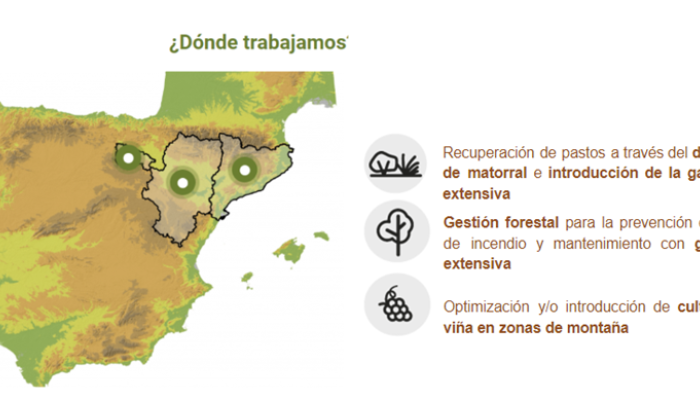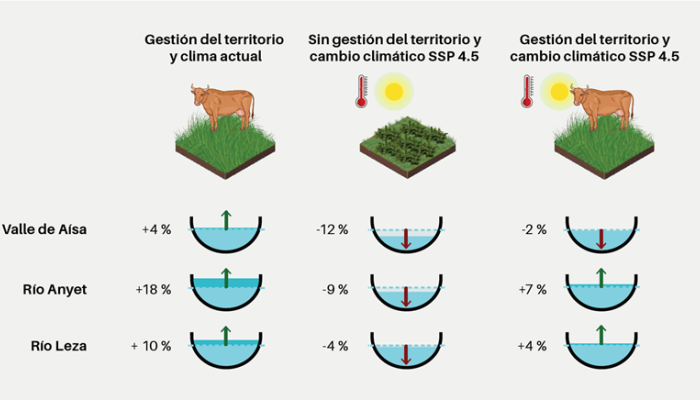
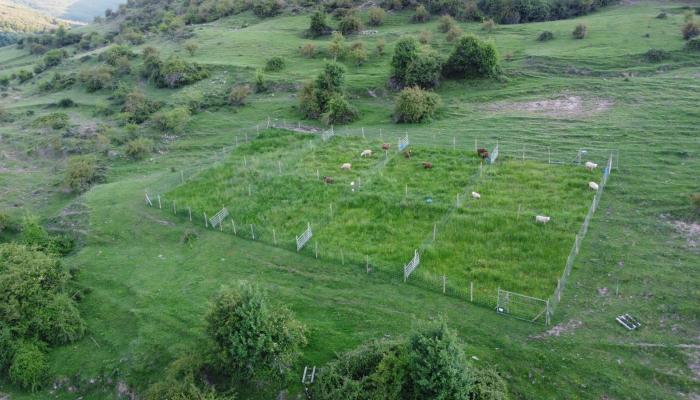
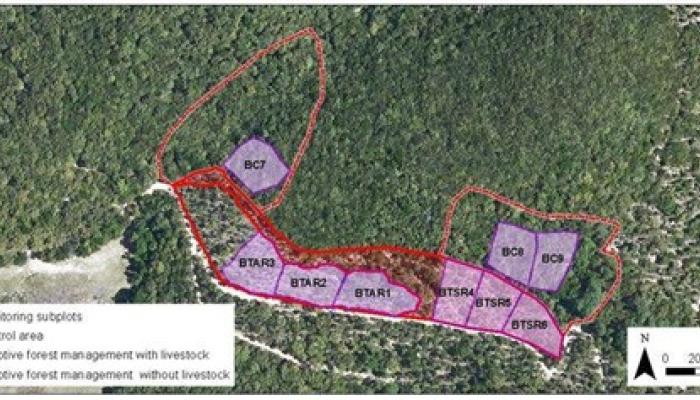
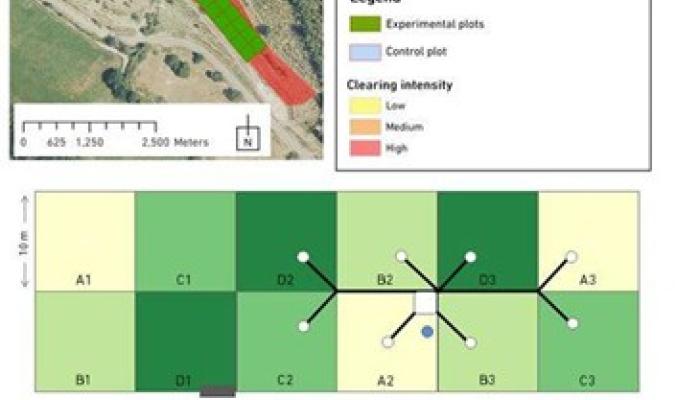
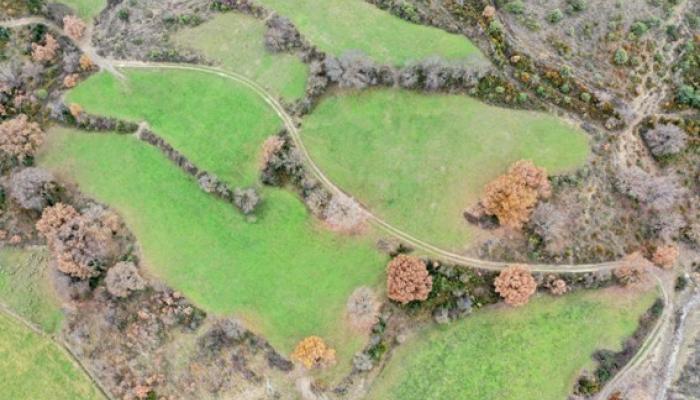
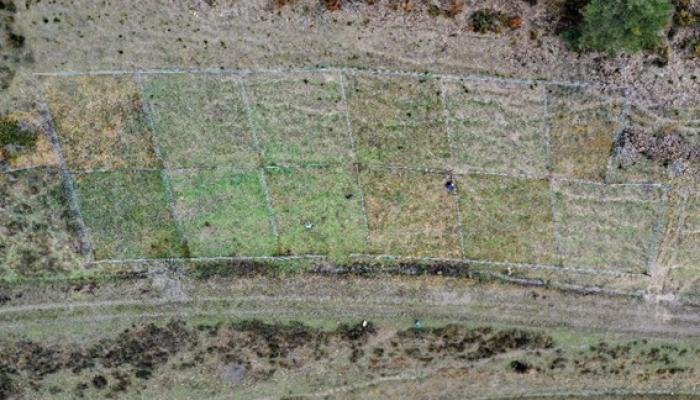
The mountain areas of southern Europe are considered highly sensitive to the impacts of climate change due to, among others, the decrease in available water, the extent and severity of droughts or the increased frequency of fires. In addition, these areas have suffered in recent decades from rural abandonment and reduced socio-economic activity, causing a progressive loss of the mosaic landscape and a revegetation of the mountain slopes.
These processes have undermined the ecological services provided by mountain areas, such as the provision of water to the lower parts of watersheds, as well as the sustainability of agricultural and forestry systems and their economic incomes.
To reverse this situation and adapt these areas to the new conditions of climate change, the project will promote the recovery of the agro-silvo-pastoral mosaic in them.
LIFE MIDMACC promotes adaptation through the implementation and testing of different landscape management measures to face the challenges related to climate change in marginal mid-mountain areas of Spain. The project is being developed in La Rioja, Aragon and Catalonia covering various bioclimatic conditions ranging from the sub-humid Mediterranean of the Pyrenees to the mid-Mediterranean mountain range of the Iberian Mountains. Adaptation measures are implemented in pilot areas in the three regions with a diversity of environmental and socio-economic characteristics that facilitate the ability to transfer results to other mountain regions in southern Europe, while enhancing their socio-economic development
The mountain areas of southern Europe are considered highly sensitive to the impacts of climate change due to, among others, the decrease in available water, the extent and severity of droughts or the greater frequency of forest fires. In addition, these are areas that have suffered in recent decades from rural abandonment and the reduction of socio-economic activity, causing a progressive loss of the mosaic landscape and a homogenisation of the mountain slopes. These processes have reduced the ecosystem services provided by mountain areas, such as the provision of water in the lower parts of the basins or the sustainability of agricultural and forestry systems and their economic income.
The conservation and restoration of biodiversity in Europe depends, among other things, on the continuity and restoration of low-intensity agricultural systems. Most of Europe's most threatened habitats and species depend on agricultural practices that co-evolved in the past in certain places in the mid-mountains. Adequate extensive livestock farming and mountain agricultural activity well integrated into the environment promote a landscape change characterized by a mosaic of uses that may include production values, important ecological and cultural values, the regulation of hydro-morphological processes and soil conservation, and the support of a great diversity of habitats.
Climate change adaptation measures in southern Europe should therefore include effective management of mountain land. The conversion and/or maintenance of a heterogeneous agro-silvo-pastoral mosaic is key, under certain criteria, for adaptation, as it can provide greater biodiversity, increase the provision of vital ecosystem services and improve resilience to shocks. The diversification of the landscape should also be a commitment to improve the economic sustainability of agricultural and forest areas in the mid-mountains.
In this context, the LIFE MIDMACC project has promoted the recovery of the agro-silvopastoral mosaic, with the aim of reversing these processes of abandonment and revegetation and adapting mid-mountain areas to the new conditions of climate change. In addition, the project has included a detailed analysis of the risks and vulnerabilities of the Mediterranean mid-mountains to the impacts of climate change in La Rioja, Aragon and Catalonia; three territories with environmental characteristics typical of the mid-mountain regions of southern Europe.
The main objective of the LIFE MIDMACC project is to promote the adaptation to climate change of the Mediterranean mid-mountain through the recovery of a mosaic landscape that is more resilient to climate change, through the implementation and monitoring of three landscape management measures in mid-mountain areas of La Rioja, Aragon and Catalonia:
- The recovery of pastures and the introduction of extensive livestock farming.
- Forest management and its maintenance with extensive livestock farming.
- Vine cultivation in mountain areas
Specifically, LIFE MIDMACC has developed and given content to the following specific objectives:
- Develop and implement landscape adaptation measures in marginal mid-mountain areas to improve their environmental and socio-economic resilience to climate change.
- To assess the socio-economic and ecological effectiveness of the measures implemented through their monitoring and modelling.
- Involve the main managers and actors of the territory in the design, development and evaluation of adaptation measures, through committees of regional decision-making actors.
- Involve the governments of La Rioja, Aragon and Catalonia in the creation of a coordinated policy framework for the sustainable use of mid-mountain areas.
- To prepare a guide with proposals for adaptation to climate change for mid-mountain areas and a manual of lessons learned.
- Carry out activities to sensitize and train the population at the local and regional levels on issues related to adaptation to climate change.
- To provide knowledge and criteria in the application and development of European policies related to adaptation to climate change.
Application of adaptive forest management for the prevention of forest fires complemented by extensive livestock farming (silvo-pastoral systems):
The pilot experiences in forest management have been implemented in wooded areas representative of the Mediterranean mid-mountains, such as a forest of Salgareño pine (Pinus nigra) and poplar (Populus nigra) on the experimental farm La Garcipollera (Aragon), and an oak forest (Quercus ilex) on the estate of Requesens (Catalonia). The forest management actions applied have been mainly based on selective thinning and clearing of shrubs to reduce the density of trees and promote mature structures with larger trees. In this way, it is intended to reduce the continuity of fuel and the risk of fire, favor the development of pastures by reaching a greater irradiation to the soil, while promoting an improvement in livestock management, in this case, of cattle.
Specifically, the effect of adaptive forest management and cattle management on soil properties, forest characteristics (fire risk, forest health status and mortality), hydrological and erosion response, and pasture production and quality has been evaluated through the analysis of plant species richness and composition. and also of nutritional quality, biomass productivity and pastoral value.
Thanks to the monitoring and follow-up of various ecological variables for 4 years, it has been shown that:
- At the landscape level, the application of these adaptive silvicultural practices significantly reduces the risk of fire and improves the state of health of the forests where complete forest management is carried out, with clearing of the understory and actions in the tree stratum. A better response is observed in those forests of a more Mediterranean nature (holm oak forests in the Albera), as they are subject to greater water stress.
- At the plot level, forest management favours a higher water content of the vegetation in periods of high fire risk, which means less flammability and combustibility of the vegetation. In addition, forest management, especially with grazing, has led to a reduction in the risk of crown fires in all plots. The role of livestock in maintaining this new forest structure with low vulnerability is key. In addition, forest management has reduced tree decay (loss of leaves and coloration), improving tree vitality, and has generated, combined with cattle grazing, biodiverse and highly nutritious herbaceous grasses under trees.
In this sense, the set of silvicultural practices applied (thinning and clearing of undergrowth, followed by the introduction of cattle under regenerative criteria) have made it possible to improve the ecological value of the forest, increasing its resilience to disturbances.
Recovery of pastures affected by the phenomenon of scrubland, through clearing and introducing extensive livestock farming:
For the recovery of pastures, the actions have been carried out in three representative areas of the Mediterranean mid-mountains in La Rioja (San Román de Cameros and Ajamil de Cameros) and in Aragón (La Garcipollera).
The actions implemented have consisted of the mechanical clearing of scrub in representative areas, the introduction of sheep, and the installation of monitoring and control plots, with the aim of evaluating the recovery of pastures as an adaptation measure to climate change.
Specifically, the effect of different sheep stocking rates on soil properties, hydrological response and erosion and pasture production and quality has been evaluated through the analysis of the richness and composition of plant species, and also of nutritional quality, biomass productivity and pastoral value.
Thanks to the established monitoring and follow-up of various ecological variables for 4 years, it has been shown that:
- At the landscape level, this adaptation strategy has been shown to bring substantial improvements in the maintenance of the mosaic landscape of the treated areas, with a considerable increase in habitat diversity, soil water content, soil quality (increased stocks of soil organic carbon and nitrogen) and the quality of the grazing resource. creating a diverse, productive herbaceous pasture with high nutritional content.
Recovery of vineyards in mid-mountain areas, applying agronomic techniques that allow adding value to these areas:
In the case of vineyards, the actions implemented have consisted of introducing agricultural practices in 5 vineyard areas in Catalonia (Celler Cooperatiu d'Espolla, the Mas Marès de Espelt Viticultors (Roses) and Llivins (Llívia) estate, and in La Rioja (the Dinastía Vivanco (Tudelilla) and Monte Laturce (Clavijo) wineries).
The different agronomic management practices tested in vineyards (different plant covers, on terraces or slopes, on trellises or goblet) with different implantation times (in active vineyards of different ages and newly established) have made it possible to clarify key elements for the implementation of this crop within a strategy of adaptation to climate change in the middle of the mountains.
Thanks to the established monitoring and follow-up of various ecological variables for 4 years, it has been shown that:
- On a landscape scale, the recovery of terraces and the implementation of new vineyards has led to an improvement in the mosaic landscape, increasing the diversity of habitats and consequently reducing the risk of forest fires. In addition to this improvement in the ecological resilience of the intervened areas, to which the vineyards confer a high natural value, it is worth mentioning the potential of obtaining a product with high added value such as the vine in these mid-mountain areas better adapted to the increase in temperatures.
- At the plot scale, vegetation cover is related to a higher content of soil organic matter and micronutrients, has a higher microbial diversity, a higher water retention and a lower erosion rate. However, vegetation cover has a negative influence on vegetative growth and crop yield, with lower production (due to resource competition) than in conventional management, but of higher quality. On the other hand, the soil and climatic context, age and management of the crop (trellis vs goblet), and slope of the land influence the microbial diversity of the soil.
Quantification of the impact of the above measures if implemented at the watershed level:
In order to predict the evolution of water resources and forest masses, and to know the effects of the different land management strategies according to different climate change scenarios, the results obtained in the pilot tests in the river basins of the Estarrún rivers (Aísa valley, Aragon) have been scaled up. and the Anyet (Catalonia) and Leza (La Rioja) rivers. To carry out this analysis at the river basin scale, an eco-hydrological model previously calibrated and validated with historical data has been used. Subsequently, future scenarios, land use and climate change have been designed which, introduced into the eco-hydrological model, have made it possible to know the effects of these scenarios on the hydrological cycle of the modelled basins.
The results of the hydrological model applied show that the lack of land management would mean that, under conditions of climate change (SSP 4.5), the average monthly flow would decrease between 4 and 12% in the three basins under study. On the other hand, the application of management measures, both in current and future climate conditions, would entail.
that this situation tended to reverse, producing, in many cases, an increase in the average monthly flow. These results show that land management could mitigate the expected loss of flow in climate change situations in the river basins of the Mediterranean mid-mountains.
The LIFE MIDMACC project is entirely planned from the perspective of adaptation to climate change. The project's demonstration experiences have been designed to objectively quantify how adaptation can reduce the vulnerability of natural systems and socio-economic activities to the impacts of climate change. In this sense, the economic and environmental costs associated with the design and implementation of these strategies to ensure greater sustainability of agro-silvo-pastoral have also been estimated, and to quantify the adaptation policies to be promoted at regional and national level in the Euro-Mediterranean mid-mountain area.
These mid-mountain areas benefit from the innovative strategies of this project. Therefore, the results of LIFE MIDMACC are highly replicable in other areas at local, national and European level thanks to the analysis and reflection process generated with an interdisciplinary character, and which has integrated the local and regional key agents in the pilot area and in 3 Euro-Mediterranean agreed areas of Italy, Portugal and Greece. The demonstrative nature of the project provides results and conclusions that contribute to improving EU knowledge and policies on adaptation to climate change, especially in rural areas.
Regional Committees: regional representatives from La Rioja, Aragon and Catalonia
Among the actors identified as regional are representatives of the sectors involved in the project (agriculture, livestock and forestry), local and regional administration, the field of research, environmental associations and civil society. To maintain its participation and commitment throughout the project, LIFE MIDMACC organized 3 regional committees. These committees met on 15 occasions and made it possible to involve the main managers and actors of the territory in the design, development and evaluation of the different priority adaptation measures in each territory (253 actors in total).
In general terms, they have also made it possible to maintain a channel of information and continuous and updated dialogue on the progress of the project with these key actors.
Supra-regional working group: key actors in the governance of the issues of interest
The main objective of the supra-regional working group has been to achieve the involvement of the governments, in this case, of La Rioja, Aragon and Catalonia, and to jointly develop a framework for coordinated political action. This group has been made up of representatives of each regional committee, guaranteeing the presence of the key sectors of the project (vineyards, forests and livestock) and affiliations (public administration, research and productive sector), having held 4 meetings with a total of 37 participants.
This working group has prioritized the barriers identified by the regional committees, selecting the 16 most significant barriers, and proposing 37 solutions to overcome them. It has also carried out a prioritisation exercise of adaptation measures identified in the regional committees, selecting the 17 priorities. Finally, they have carried out an exercise of reflection on how to influence the adoption of adaptation actions in public policies. They have also validated the climate vulnerability analysis carried out for each territory and have contributed to the Lessons Learned Manual, prioritizing the fundamental elements and defining the focus of the document.
Regarding awareness and dissemination actions, the LIFE MIDMACC project has carried out:
- 279 publications and posted more than 50 articles and documents on the https://life-midmacc.eu/ website.
- 19 project information panels have been placed and installed in the different experimental plots and headquarters of the project partners.
- 1,000 printed brochures have been distributed.
- 6 posters have been presented, with an audience of 1,800 people.
- 15 scientific and informative articles have been published, with a potential audience of 7,875 people.
- More than 900 tweets have been made, with more than 700 followers on the https://x.com/midmacc account.
- 100 conferences have been attended, with an audience of 7,409 people.
- 89 publications have been made in the media, with a potential audience of 1,694,183 people.
- 16 projects have been contacted for networking.
- 11 guided tours have been carried out in the pilot areas, with the participation of 260 people (master's, undergraduate and high school students, researchers and producers).
- 5 activities have been carried out in primary schools, with the participation of 260 students.
- Se ha organizado una sesión científica en la Asamblea General de la EGU en Viena, Austria, bajo el título: Session ITS3.4/NH13.4. Navigating socio-ecological systems in mountain regions and beyond: addressing land use change, water resources, and global change adaptation
- -7 dissemination videos have been created available in the LIFE MIDMACC list of the OPCC YouTube channel
- Living mountains, resilient mountains.
- The potential for transferability and replicability.
- Adaptive management of viticulture in mountains and mid-mountains, a key component of the landscape mosaic.
- Adaptive management of mountain and mid-mountain pastures and forests.
- Scaling up climate change adaptation measures using the Regional Hydroecological Simulation System.
- The success story of the vineyards of Roses to stop a fire in winter 2022.
- Climate change adaptation measures in the Mediterranean mid-mountains.
One of the highlights of the LIFE MIDMACC project has been the design and development of replicability and transfer actions to enhance the impact of the project beyond the study areas. These efforts have taken the form of a series of actions aimed at promoting the replication of the LIFE MIDMACC strategies in other European mountain areas. Through the signing of replicability agreements, 3 entities representing different European mountain areas have been able to closely follow the pilot experiences of the project. Specifically, these agreements have made it possible to establish a close dialogue channel between the LIFE MIDMACC partners and the signatory entities.
Among other actions, reciprocal visits have been organised to learn about the LIFE MIDMACC pilot experiences and the study areas of the signatory territories. On the other hand, they have made it possible to organize thematic workshops with the Regional and Supraregional Committees, as well as Transfer Seminars to improve and adapt each of the LIFE MIDMACC strategies to the specificities of the mountain territories of the partners adhering to the agreement.
The LIFE MIDMACC project has focused on enhancing the replicability of its 3 adaptation strategies both in the territories of the pilot trials, in the Pyrenees, and in other Mediterranean mid-mountain areas. One of the success factors of LIFE MIDMACC has been the transfer and replicability action. Firstly, through the supra-regional working groups, it has been possible to transfer the successes of the adaptation strategies tested to all the target groups of the project, from the heads of the regional public administrations involved, to the local entities directly involved and even to the primary sector (agro-livestock and forestry), an indispensable collaborator in the implementation of the new strategies.
Secondly, this project action has also made it possible to establish a channel of continuous dialogue to forge synergies with other European mountain territories, to promote the replication of the LIFE MIDMACC strategies in other mid-mountain areas.
Thanks to this action, 3 European mid-mountain territories have carried out a co-learning process that will allow replicating and promoting the MIDMACC strategies in their respective territories.
In both cases, the success factor has been to generate interest, ensure the involvement of the target audience through periodic participatory dynamics and an iterative process of exchange that has led to the development of the LIFEMIDMACC lessons learned manual (see the manual here). This manual is the result of a process of critical analysis by all the actors of the LIFE MIDMACC project.
The main obstacles to the effective replication of the LIFE MIDMACC experiences both in the project territories and in other European mountain areas have been essentially economic. On the one hand, at the internal level, farms are in a limit situation at an economic level, highly dependent on European aid. For this reason, an external impulse is necessary to show new management possibilities that allow improving economic and environmental sustainability. This transition often requires large investments to adapt farms and their management. Externally, the project has included the signing of replication agreements, as well as the necessary workshops to adapt the different strategies to each replicator territory, but the implementation itself oversees the replicator territories and their fit with other sources of funding.
The LIFE MIDMACC project has had a total budget of €2,595,725 euros, with a contribution from the European Union of €1,427,639 through LIFE funds. The rest of the funding has been provided by all the project's partner entities (45% self-financing).
The LIFE MIDMACC project also includes a socio-economic analysis of the 3 strategies implemented. This analysis provides very useful economic information so that the different actors involved in the management of the territory can assess the possibilities of applying the climate change adaptation measures implemented by the project, and their cost-benefit relationship, also considering the ecosystem services (availability of water resources, reduction of fire risk...).
Clearing and fire risk:
LIFE MIDMACC has carried out a comparative analysis between La Rioja (a pioneer in clearing plans for the control of forest fire risk) and Castilla y León (control area). Since the application of the La Rioja Clearing Plan at the end of the 80s, the hectares burned per year have been reduced by 79%. This type of management is based on mechanical clearing of scrub combined with livestock grazing, thus reducing forest biomass and creating a mosaic landscape, with forests alternating with scrub and pasture areas. In this way, it is possible to reduce the burning of pastures carried out by livestock farmers, often the origin of fires by accident. The application of clearing contributes significantly to reducing the probability of a forest fire (between 67 and 77%). In the area examined, La Rioja, compared to the control area, Castilla y León, where prescribed burns are carried out, a reduction in the burned forest area of 86.2% has also been achieved in recent years.
The costs of extinguishing and the losses derived from the fires become higher in the control zone, where management is carried out based on prescribed burns. In La Rioja, where clearing has helped to reduce the risk of fire, losses per hectare burned are significantly lower, at around €240/ha burned. Thus, the management of the territory by applying these forest management techniques and clearing accompanied by extensive livestock avoids losses of €1,036/ha burned, in addition to significantly reducing extinction costs/ha.
Extensive livestock farming:
In order to know the feasibility of applying extensive livestock farming as an adaptation measure, LIFE MIDMACC has carried out an economic analysis of 3 privately managed livestock farms and one public farm, where the product for sale corresponds to cows, sheep and/or goats, mainly for fattening (for more information see here the full study). This analysis has made it possible to identify the set of factors that determine the viability of extensive livestock farming as a measure of adaptation to the landscape. These factors are: livestock supplementation (accounts for between 50% and 60% of total expenditure per livestock unit), the marketing of offspring (reduces supplementation costs and provides between 28% and 72% of profits), CAP subsidies and aid (essential for the economic viability of farms but viewed by farmers with reluctance because they consider in many cases the excess of procedures bureaucratic resources to be carried out), availability of pasture (the quantity and type of pasture area available can be decisive in determining economic viability) and labour and generational replacement (the low profitability of farms often conditions the availability of labour, and the scarcity of certain services in some rural populations reduces their attractiveness for the establishment of new workers).
Undoubtedly, the increase in grazing areas and their recognition at the legal level is a great conditioning factor to achieve greater viability with less dependence on food supplements, as long as they are accompanied by improvements of a social nature and quality of life for the primary sector.
Economic impact of the greater availability of water resources.
The measures analysed at the basin level in Aísa (Aragon), Anyet (Catalonia) and Leza (La Rioja) confirm an improvement in the water balance derived from the management measures applied, marked depending on the climate scenario used. In general terms, the increase of 1 hm3 in water resources has an impact of €3.5 million, of which €275,424 correspond to the direct impact on the agricultural sector, and €3,204,230 to the indirect impact on all economic sectors thanks to the carry-over effect of greater agricultural production. Specifically, it would allow a direct increase of 52% in irrigation-dependent crops in the area. (see here is the complete study). About the net present value of the benefits derived from the increase in the availability of water, it can be seen that in the Aísa area it ranges from €51.29 to €199.16 per hectare intervened after the clearing and clearing actions in the different climate change scenarios on the exported water resources. In the Anyet basin and in the Leza valley the benefits are more notable and are around €7,000 and €4,500/ha intervened on average in the different scenarios considered.
On the one hand, the LIFE MIDMACC project has been designed to provide elements for improving current land management policies in European mid-mountain areas. Through pilot experiences on extensive livestock farming, adaptive forest management, vineyards and clearing, the project has sought to clarify some key aspects to increase the resilience of these mid-mountain areas, often referred to as "marginal" due to the socio-economic drift of recent decades.
In addition, with the intention of ensuring that the results and recommendations of the project have an impact on the design of new environmental policies at European level, LIFE MIDMACC has participated in different initiatives coordinated with other projects.
Contribution to the Policy Paper Policy paper A step forward in Forest policy: the Mediterranean perspective, presented in Brussels on 31/05/2022, as a PARTNER event of the EU GREEN WEEK 2022.
Contribución al Documento de posición conjunta Joint position paper A step forward common policies for southern European mountain’s pastoral Systems.
Contribution to the EURAF Policy briefing 44 Agroforestry systems in the Spanish CAP Strategic Plan: analysis and reflections.
01/07/2019- 30/06/2024
- LAYMAN’S REPORT. LIFE MIDMACC Mid- Mountain adaptation to climate change LIFE18 CCA/ES/001099 – 2019-2024
- Sans F, Terrádez J, García E, Pascual D, Pla E (2024) Integrated Adaptation Guidelines: Handbook of Lessons learned and replication protocols. Deliverable 24 LIFE MIDMACC.
- Pascual D, Pla E, Nadal-Romero E, Lasanta T, Zabalza J, Foronda A, Pueyo Y, Reiné R, Barrantes O, Lana-Renault N, Ruiz P, Lorenzo J (2024) Report with the final monitoring results of the implementation action C2. Deliverable 31 LIFE MIDMACC.
- Nadal-Romero, E., Zabalza, J., Errea, M.P., Llena, M., Revuelto, J., Foronda, A., Lasanta, T., Pueyo, Y., Reiné, R., Barrantes, O., Lana-Renault, N., Ruiz, P., Lorenzo, J., (2024) Report with the final monitoring results of the implementation action C1. Deliverable 30 LIFE MIDMACC
Juan Terrádez Mas
- mail: j.terradez@ctp.org
CREAF – Edifici C. Campus UAB
08193 Bellaterra (Barcelona). España
Tel: +34 93 581 46 75
info@life-midmacc.eu



